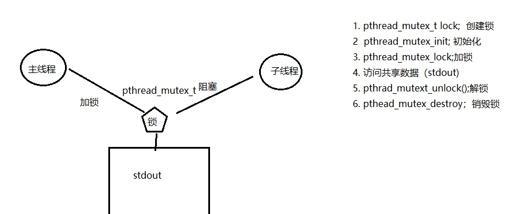
Linux线程同步:三种方法之一-互斥锁
时间:2023-05-19 来源:网络 人气:
在多线程编程中线程同步的方法有哪些?Linux下实现线程同步的三[荐],线程同步是一个非常重要的概念。因为多个线程同时访问共享资源时,可能会导致数据不一致、死锁等问题。因此,在多线程编程中,必须采用一些手段来保证线程之间的同步。接下来,我们将深入探讨Linux下实现线程同步的三种方法。
互斥锁(Mutex)
互斥锁是最常见的一种线程同步方式。互斥锁采用了一种排他的方式线程同步的方法有哪些?Linux下实现线程同步的三[荐],即同一时间只能有一个线程访问共享资源。当一个线程获得了互斥锁后,其他线程必须等待该线程释放互斥锁后才能继续访问共享资源。
线程通信和同步linux_hashtable是怎么实现线程安全的_线程同步的方法有哪些?Linux下实现线程同步的三[荐]
下面是一个使用互斥锁的示例程序:
c
#include
#include
intcounter=0;
pthread_mutex_tmutex;
void*thread_func(void*arg)
{
inti;
for(i=0;i<10000;i++){
pthread_mutex_lock(&mutex);
counter++;
pthread_mutex_unlock(&mutex);
}
returnNULL;
}
intmain()
{
pthread_tthread1,thread2;
pthread_mutex_init(&mutex,NULL);
pthread_create(&thread1,NULL,thread_func,NULL);
pthread_create(&thread2,NULL,thread_func,NULL);
pthread_join(thread1,NULL);
pthread_join(thread2,NULL);
printf("counter=%d\n",counter);
return0;
}
在上面的示例程序中,我们使用了pthread_mutex_t类型的互斥锁来保证counter变量的线程安全。在每个线程中,我们使用pthread_mutex_lock函数来获取互斥锁,使用pthread_mutex_unlock函数来释放互斥锁。这样就能保证同一时间只有一个线程能够访问counter变量。
线程通信和同步linux_线程同步的方法有哪些?Linux下实现线程同步的三[荐]_hashtable是怎么实现线程安全的
条件变量(ConditionVariable)
条件变量是另一种常见的线程同步方式。条件变量可以让线程等待某个条件成立后再继续执行。在Linux下,条件变量通常和互斥锁一起使用,以保证线程之间的同步。
下面是一个使用条件变量的示例程序:
线程通信和同步linux_hashtable是怎么实现线程安全的_线程同步的方法有哪些?Linux下实现线程同步的三[荐]
c
#include
#include
intcondition=0;
pthread_mutex_tmutex;
pthread_cond_tcond;
void*thread_func1(void*arg)
{
pthread_mutex_lock(&mutex);
while(condition==0){
pthread_cond_wait(&cond,&mutex);
}
printf("Thread1:conditionis%d\n",condition);
pthread_mutex_unlock(&mutex);
returnNULL;
}
void*thread_func2(void*arg)
{
pthread_mutex_lock(&mutex);
condition=1;
pthread_cond_signal(&cond);
pthread_mutex_unlock(&mutex);
returnNULL;
}
intmain()
{
pthread_tthread1,thread2;
pthread_mutex_init(&mutex,NULL);
pthread_cond_init(&cond,NULL);
pthread_create(&thread1,NULL,thread_func1,NULL);
pthread_create(&thread2,NULL,thread_func2,NULL);
pthread_join(thread1,NULL);
pthread_join(thread2,NULL);
return0;
}
在上面的示例程序中,我们使用了pthread_cond_t类型的条件变量来保证线程之间的同步。在线程1中,我们使用pthread_cond_wait函数来等待条件成立,在线程2中,我们使用pthread_cond_signal函数来通知线程1条件已经成立。
信号量(Semaphore)
线程通信和同步linux_hashtable是怎么实现线程安全的_线程同步的方法有哪些?Linux下实现线程同步的三[荐]
信号量是一种更为复杂的线程同步方式。信号量可以用来控制对共享资源的访问数量。在Linux下,信号量通常采用SystemVIPC机制实现。
下面是一个使用信号量的示例程序:
c
#include
#include
#include
intcounter=0;
sem_tsem;
void*thread_func(void*arg)
{
inti;
for(i=0;i<10000;i++){
sem_wait(&sem);
counter++;
sem_post(&sem);
}
returnNULL;
}
intmain()
{
pthread_tthread1,thread2;
sem_init(&sem,0,1);
pthread_create(&thread1,NULL,thread_func,NULL);
pthread_create(&thread2,NULL,thread_func,NULL);
pthread_join(thread1,NULL);
pthread_join(thread2,NULL);
printf("counter=%d\n",counter);
return0;
}
hashtable是怎么实现线程安全的_线程通信和同步linux_线程同步的方法有哪些?Linux下实现线程同步的三[荐]
在上面的示例程序中,我们使用了sem_t类型的信号量来保证counter变量的线程安全。在每个线程中,我们使用sem_wait函数来获取信号量,使用sem_post函数来释放信号量。这样就能保证同时只有一个线程能够访问counter变量。
通过上述分析,我们可以看出,在Linux下实现线程同步有三种方式:互斥锁、条件变量和信号量。每种方式都有其独特的优缺点,应根据具体情况选择合适的方式。

imtoken钱包:https://cjge-manuscriptcentral.com/software/5777.html
相关推荐
5G专题
5G专题排行
- 1 光有姓名怎么查身份证号-如何查询他人身份证号?三种简单有效的方法,不容错过
- 2 游戏虚拟身份证号码2023-2023虚拟身份证号码推出:游戏玩家的新便利和社区加强
- 3 有身份证号怎么查询手机号-如何通过身份证号查询他人手机号?多种途径帮您快速解决问题
- 4 2023免费已成年身份证号-2023年起,成年人可免费领取身份证号,办事更便捷
- 5 激活神器kmspico win10激活工具-KMSpicoWin10激活工具:探秘稳定高效的神器,解
- 6 知道电话和名字怎么查身份证信息-如何查询身份证信息:通过电话号码或姓名,快速获取个人身份信息
- 7 怎么通过身份证号查询名字-如何通过身份证号查询姓名?详解两种查询方法
- 8 怎么输身份证号查姓名信息-如何安全可靠地查询身份证号对应的姓名信息?了解这些方法保护个人隐私
- 9 通过姓名电话怎么查身份证号码-如何查找某人的身份证号码?三种方法告诉你
- 10 怎么查身份证号码和真实姓名-如何查询他人的身份证号码和真实姓名?几种简单有效的方法分享

系统教程
- 1 ecos 安装-ECOS 安装的爱恨情仇:一场与电脑的恋爱之旅
- 2 北京市监控员招聘:眼观六路耳听八方,责任重大充满挑战
- 3 php冒泡排序的几种写法-探索 PHP 中的冒泡排序:编程艺术与心情表达的完美结合
- 4 汽车电控系统结构-汽车电控系统:ECU 与传感器的完美结合,让驾驶更智能
- 5 gtaiv缺少xlive.dll-GTAIV 游戏无法运行,XLive.DLL 文件丢失,玩家苦寻解
- 6 crisis公安机动百度云-危机时刻,公安机动部队与百度云的紧密合作,守护安全
- 7 刺客信条枭雄突然停止-玩刺客信条:枭雄时游戏突然停止,玩家心情跌入谷底
- 8 上海专业数据恢复,让你不再为丢失数据而烦恼
- 9 冠心病护理措施-呵护心脏,从饮食、运动和情绪管理开始,远离冠心病
- 10 分区魔术师使用-分区魔术师:让电脑硬盘井井有条的神奇工具
-
标签arclist报错:指定属性 typeid 的栏目ID不存在。












